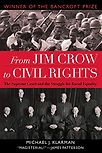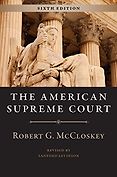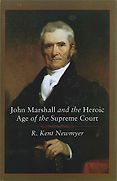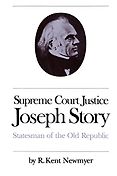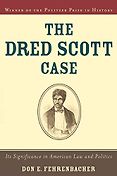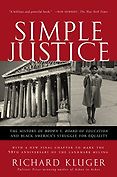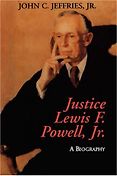The Supreme Court is the highest court in the United States. Before we get to the books, tell us what it tops: brief us on the American judicial system, please.
The Supreme Court is at the apex of two parallel systems—a federal court system and a state court system. If a state court is interpreting a federal statute or the federal Constitution and the Supreme Court thinks they’re getting it wrong, the Supreme Court can review that state court’s decision. The rest of the federal courts cannot review state court decisions. So, if somebody is bringing an antitrust claim under a federal statute, they’ll usually bring that claim in federal court; if somebody is suing for an injury incurred during a car accident, they’ll usually bring that claim in state court. The U.S. Constitution only creates one federal court, which is the Supreme Court. But it does authorize Congress to create a system of lower federal courts, which Congress did during its very first meeting, in 1789. The Supreme Court does not have the authority to interpret state law, that’s left to the state courts. But if there’s a federal constitutional challenge to a state law, then the Supreme Court can review it, since it is at the apex of the system to review cases coming up through the federal courts and the state courts.
The Supreme Court is the final arbiter of what the Constitution means. But you lay bare the “indeterminacy of constitutional law,” in your Bancroft Prize-winning book, From Jim Crow to Civil Rights.
That book describes the Supreme Court’s contributions to the issue of racial equality and racial justice from the Civil War to the civil rights movement. There are a few different themes in the book. One of them is that constitutional phrases like “equal protection” don’t have a tremendous amount of determinacy. In addition, justices disagree about the appropriate methodology of interpretation. Court precedents can be interpreted narrowly or broadly or overturned, meaning that the justices have a fair amount of discretion in how they interpret the Constitution. In the book, I argue that the Supreme Court, to a significant degree, is a reflection of the cultural and historical moment in which the justices operate.
For example, in 1896, the Court upheld racial segregation, in Plessy vs. Ferguson, at a time that most white Americans were supportive of white supremacy. But then, after World War II, the country was revisiting its views about race, partly as a result of fighting a war against Nazi fascism, partly because of the role of Black soldiers in the war, partly because the United States was battling the Soviet Union for the hearts and minds of the Third World, which had different views about race. At the time that the Court decided Brown vs. Board of Education in 1954, American race relations were in flux, which made it possible for the Supreme Court to decide Brown the way that it did.
“Court decisions can sometimes make issues salient…they can energize both supporters and opponents.”
We can also see how the Court reflects the cultural moment today. Recently, the Supreme Court held that gay marriage was constitutionally protected. The justices would never have done that 30 years ago. Most Americans couldn’t have conceived of the idea that there was a constitutional right to gay marriage 30 years ago, but society changes, popular mores change, and the Supreme Court is not oblivious to that. Last term, even two of the conservative justices joined a ruling that Title VII of the 1964 Civil Rights Act, which forbids sex discrimination in employment, also forbids discrimination based on sexual orientation and transgender status. That’s from judges who purport not to be very activist. So, the law is indeterminate enough that they were able to interpret it in a way that reflected changing mores.
You continue to explore the connection between the Court and public opinion in From the Closet to the Altar, right?
I was interested in the phenomenon of court decisions that get in front of public opinion and produce backlash. Brown vs. Board of Education decided the school segregation issue in a country that was divided down the middle. But the South wasn’t divided down the middle, and the Court’s decision produced a dramatic political backlash, radicalizing Southern politics, creating a climate that was ripe for violence and leading Southern States to massively resist the decision. You can argue the Court’s death penalty decisions, and its abortion decision, had similar effects.
That’s very much what happened with gay marriage. A decision from Hawaii in the early 1990s led to backlash and the passage of the Defense of Marriage Act. Then there was the Massachusetts decision, in 2003, which led George W. Bush to run for reelection on a platform of supporting a constitutional amendment to ban gay marriage. I was interested in that dynamic, how court decisions can sometimes make issues salient, how they can energize both supporters and opponents. Then the Supreme Court in 2015, kind of late in the game, decided to resolve the issue for the country; the justices waited long enough that there wasn’t significant backlash to that decision, although there was some. I’d argue that part of the reason why Donald Trump won the support of 81% of white evangelicals in 2016 is because the gay marriage decision crystallized their perception that the nation was turning away from its traditional Christian roots. So, they rallied behind a president who promised to appoint anti-abortion judges and who reenforced their feeling that Christianity was under attack.
Let’s move on to your book choices. First let’s discuss the classic treatment of the topic, now in its sixth edition. Tell me about Robert G. McCloskey’s The American Supreme Court.
McCloskey was a political scientist at Harvard who wrote this book in about 1960. It used to be that the best constitutional history was written by political scientists and government scholars. Now, most of the people writing the best constitutional history are in law schools. But there’s also been a big shift in law schools in the last 40 years. Many of my colleagues have PhDs in government or history. The people who 50 years ago would have been writing legal history books in government departments, are now writing them in law schools. Nevertheless, someone who earned a doctorate in government or political science has a different approach than somebody who’s trained only in law. In any event, McCloskey was a brilliant scholar of the Court.
What I love about the book is that he sets the Supreme Court in its broader political and social context. He sees the Court as a creature of its times and as a political institution, which is the approach that I gravitate towards. He’s not that interested in legal doctrine, meaning the rules that courts come up with to interpret statutes or the constitution, for a free speech case or an equal protection case. I don’t think those doctrines really determine the outcomes in particular cases and neither does McCloskey.
“It’s not unusual for a Court decision that advances too far beyond what public opinion will accept to produce backlash. Justices are aware of that”
He’s more interested in things like how the great John Marshall, the Chief Justice for 34 years in the early 19th century, writes his nationalism into the Constitution. And how does the Court under Chief Justice Roger Taney come up with proslavery rulings? And what are the political implications of those rulings? He looks at the Court’s contributions to American history through that lens. He also focuses on the Court during the ‘Lochner era,’ the first few decades of the 20th century, when the Supreme Court was striking down economic regulation, and he talks about the Court crisis over the New Deal.
When I have LL.M. (Master of Laws) students, who are usually from other countries, take my constitutional law class or one of my constitutional history classes, I always suggest this book as background reading. It’s been updated to the present by another eminent constitutional law scholar, Sanford Levinson. But even the 1960 edition is useful for introducing oneself to the American Supreme Court and its history.
The United States has a three-branch system of government. The executive, legislative and judicial branches were designed to be co-equal. What happens when the Supreme Court, which sits atop the judicial system, is out of step with the other branches of government?
McCloskey looks at the Supreme Court, as political scientists do, as part of a three-branch system of government. If the Supreme Court goes too far in challenging Congress, Congress has various weapons to use against the Supreme Court. Justices are well aware of that. So during Reconstruction, in the 1860s and 1870s, Congress was at odds with what Republicans thought was a hostile Supreme Court that might strike down their Reconstruction legislation. So Congress took away the Court’s jurisdiction in a case that had already been argued. The Reconstruction-era Supreme Court justices were intimidated and backed off. That happened in 1937 as well.
I believe we’re again entering an era when, if the Court engages in too much conservative policymaking, liberals might retaliate by expanding the size of the Court, which is something that Democrats are starting to talk pretty actively about for the first time in many decades.
Let’s move on to a biography, John Marshall and the Heroic Age of the Supreme Court by R. Kent Newmyer. Please tell us about it.
Kent Newmyer is a great judicial biographer who wrote what I think many people would regard as the greatest judicial biography, the Joseph Story biography. This is my favorite among the many Marshall biographies. I’m inclined toward books that take the same approach that I do, which is putting the justices in their context, not suggesting they’re somehow neutral interpreters of the law, but rather acknowledging that they reflect their own experiences and they reflect the time period in which they exist.
Before he was Chief Justice, John Marshall was a politician from Virginia and a participant in the 1788 Virginia Convention that ratified the Constitution. He was a leading commercial lawyer in Richmond during the 1790s, then served one term in Congress. But he made a name for himself in that term, defending the Federalist Party’s policies. A large part of what he’s famous for is reading nationalism into the Constitution. Decisions like McCulloch versus Maryland, in 1819, upheld the constitutionality of the Second Bank of the United States and established a very broad reading of congressional power. In his home state of Virginia, Richmond newspapers criticized the decision. Marshall responded pseudonymously in essays defending his decision.
Get the weekly Five Books newsletter
Newmyer talks about where this nationalism came from. Marshall had been a soldier during the Revolutionary War and, like many participants in it, he emerged with a very nationalist inclination, partly because soldiers had risked their lives to build a nation and also because one of the obstacles to the war’s success was the obstinacy and obstructionism of the states. That made them inclined to support nationalism versus states’ rights. Marshall was also presiding over a Federalist Court, meaning a Court that shared the Federalist philosophy of John Adams and Alexander Hamilton, at a time when political opposition to that philosophy was ascendant. To survive the Jeffersonian era and then later the Jacksonian era, he becomes a political strategist. Marshall tries to decide cases without provoking political adversaries, who could destroy him. McCulloch helps us understand how John Marshall wrote his philosophy into the Constitution, in a strategic way so that he doesn’t get swamped by the political opposition.
You’ve insisted on a two-for-one deal, naming a second book by Newmyer, Supreme Court Justice Joseph Story: Statesman of the Old Republic as part of your first choice. Why is this book indispensable? What does the story of Justice Story teach us about the story of the Supreme Court?
Story was another justice who served for 30 years; he was appointed in 1812 and served until 1845. He and Marshall were allies on the Court. He was an extreme nationalist. Partly that’s a reflection of his New England roots; New England is where the Federalists were especially strong. Story was a brilliant lawyer. He’s a founder of Harvard Law School. He taught at Harvard Law School. Some of the most interesting issues involving his time in the Court are slavery issues. Story, like most people in Massachusetts, was anti-slavery. He was responsible for deciding many cases involving slavery. As a judge who was personally opposed to slavery, he faced the problem that the Constitution was pretty clearly pro-slavery.
Story wrote the opinion for the Court in an 1842 case called Prigg vs. Pennsylvania, which determined whether the federal Fugitive Slave Act of 1793 was inconsistent with a Pennsylvania law that tried to protect free Blacks from being kidnapped. If Story were to say that the federal Fugitive Slave Law was unconstitutional or that the Pennsylvania law somehow survives the federal statute, you might very well expect Southern slaveowners to just walk out of the union. So he’s trying to balance conflicting interests. His dilemma provokes really profound questions about what a judge is supposed to do when their moral views are affronted by the law. He writes a very interesting opinion. That’s only a small part of the book.
Story was very active in all sorts of areas of law. He also served when South Carolina was threatening to nullify the federal tariff in the early 1830s. There’s great correspondence between John Marshall and President Andrew Jackson. Story and Marshall were very pessimistic about the state of the union in the early 1830s. They were profoundly opposed to Andrew Jackson and his policies. So there’s a lot of fascinating correspondence and extrajudicial writings by Story. Story also wrote the most distinguished commentaries on the Constitution of that era. Newmyer explores all of that as well. It’s a terrific biography, judicial biography at its best.
Don Fehrenbacher’s The Dred Scott Case, which won a Pulitzer, is your next pick.
Dred Scott is one of the most infamous decisions in American constitutional history. Don Fehrenbacher, who was a historian at Stanford, gets 600 fascinating pages out of it. The issue was whether Congress could bar slavery from federal territories. Back in 1787, Congress passed the Northwest Ordinance, which barred slavery from the Northwestern territory of the United States, the area that later became Ohio, Illinois, Indiana, etc. Fehrenbacher follows that story through the various political crises provoked by slavery—the 1820 Missouri Compromise, the fight over the Kansas-Nebraska Act in 1854. Then you get to Dred Scott in 1857.
A doctor in the army, who started out in Missouri and spent time in Illinois and the Minnesota territory, considered himself to be the owner of Dred Scott. When the doctor returns to Missouri, abolitionists in St. Louis get wind of the fact that Dred Scott has been taken to jurisdictions where slavery is forbidden. They bring a lawsuit, which winds its way through the state courts. Then the lawsuit winds its way through the federal courts to the Supreme Court. At that time, many feared the five Southern justices would split with the Northern justices in a way that would split the country. Fehrenbacher reveals the detailed internal history of how President James Buchanan tries to get the justices to write an opinion that will not reflect their regional split. He gets the justices to reveal what the decision will say so when he writes his inaugural address, which is delivered just before the Dred Scott decision comes down, he asks the nation to rally around the Supreme Court.
Then Fehrenbacher faces the question of the decision’s impact. Some people think Dred Scott helped cause the Civil War. He analyzes what exactly happens after Dred Scott; he looks at the state elections to figure out whether Dred Scott helped the Republican party. Does it produce a backlash that leads to Lincoln’s election? It’s 600 pages of brilliant legal and political history. Dred Scott is often seen as the most egregious decision in American constitutional history. Yet most Americans, ironically, almost certainly agreed with it when it was decided. It’s only with the aid of hindsight that it seems like such an abomination.
Dred Scott was the first time the Supreme Court invalidated a major piece of federal legislation. Your work highlights the “unpredictable consequences of Supreme Court decision-making.” Do the justices consider consequences when considering a case? Please give us other prime examples of the unpredictable consequences of decisions.
Justices always think about those things, though most of them would deny it publicly. Chief Justice Taney clearly believed that he was doing the country a service by taking on the issue of slavery in the territories, which was too controversial for Congress, literally. Congress could not resolve it because the South tended to control the Senate and the North tended to control the House, so Congress was in a deadlock in 1849-1850, over what to do with slavery in the territory that had been acquired in the war with Mexico. So Chief Justice Taney thought he was taking a hot potato issue off the table and binding the country together by taking on Dred Scott.
“Dred Scott is one of the most infamous decisions in American constitutional history”
They do that sort of thing all the time. That’s what the Supreme Court tried to do in the 1992 Casey abortion case, where the plurality opinion quite clearly says, ‘we are calling on the nation to come together and respect our decision on abortion.’ In a 2012 case, the Court came within an inch of striking down the Affordable Care Act, but we know that Chief Justice Roberts got cold feet at the last moment about striking down what was arguably the most important piece of domestic legislation since the 1960s in the midst of a presidential election. Other examples include Bakke, the famous affirmative action case in 1978. Four justices wanted to strike down affirmative action, and four justices wanted to uphold affirmative action. Justice Powell was the decisive vote. He split the difference. He said some forms of affirmative action are okay, but what the University of California Davis has done here is not okay. These decisions purport to be legal, but they’re statesman-like efforts to split the difference between the two sides.
As for unpredictable consequences from decisions, in 1972 five justices clearly thought they were invalidating the death penalty. They were shocked when 35 states passed new death penalty laws within the next four years. And public opinion polls showed dramatically increased support for capital punishment. Four years later, the Court agreed to allow some forms of death penalty statutes and not others. It’s not unusual for a Court decision that advances too far beyond what public opinion will accept to produce backlash. Justices are aware of that. Even though they would deny that this is a legitimate thing to take into account, they do it all the time.
Simple Justice by Richard Kluger is next. Please tell me about it.
If I had to recommend one book about law or about the Supreme Court, this is the book I would pick. Kluger is a journalist; as far as I know, he doesn’t have a legal education. He decided to write the definitive history of the Brown vs. Board of Education litigation and he wrote a gripping, page-turning story. Brown began as five cases; he goes back to each of the five locations to tell the story of the litigation. Many people know what the Supreme Court did with its 1954 decision in Brown, but they don’t know how the case got there.
The litigation in Virginia started with Black students in Prince Edward County, which is a county where slavery was pervasive and where Black children were probably more than 50% of the school population around 1950. These children didn’t get bus transportation, whereas whites did, and their schools were dilapidated, whereas white students had fancy new schools with modern amenities. So Black children decided to strike for equal funding; they were not demanding integration. The NAACP (National Association for the Advancement of Colored People) got wind of this. The NAACP said to them, ‘We’re not interested in bringing cases just to achieve material equality, we want integration.’ So it’s an example of how heroic kids were out in front on this issue. Kluger is such a good storyteller that the courage of these kids comes leaping off the page.
He also writes the history from within the Supreme Court, and it turns out it’s a fascinating internal history, which is well preserved in memos between the justices and justices’ conference notes on their deliberations. I’ll give you an example from the book. The case was first argued in December 1952. The justices had real doubts about what to do. Kluger recaptures their conversations in some detail, using their conference notes, and captures the debate using memos between the Justices and memos from law clerks. They ended up putting the case over for re-argument, then the Chief Justice dies, and President Eisenhower picks a new Chief—Earl Warren, who was the Governor of California. He goes through all of this and it reads like a novel, but it’s about the most important court case in United States history. Kluger’s book is now 45 years old, but it’s still incredibly valuable.
You mentioned the transition of chief justices during Brown. Supreme Court history tends to be taught as a series of epochs, known by the surname of the presiding chief justices of each period. Under this approach, Brown was decided during the Warren Court. Can you explain how this works? Why do we see the Courts as dominated by their chiefs? Does that conceptualization lead to misunderstanding about how the Supreme Court really works? Does this historiographical approach shape the role of the court in our country?
It’s probably a misleading way to think about the Court. There’s no reason to think that any particular chief justice represents the Court and there’s no reason to think that the appointment of a chief justice at a particular moment will change the nature of the Court’s jurisprudence. It is true that Chief Justice Earl Warren left in 1969 and another liberal justice, Abe Fortas, left that same year. Nixon was able to appoint a new chief justice and several additional conservative justices within a few years. That fundamentally changed the nature of the Supreme Court. So it probably is accurate to see the shift from the Warren court to the Burger Court as pretty significant, but it’s not because of the changes in chiefs so much as it is because of the fact that Nixon got four appointments during his first term in office.
Five Books interviews are expensive to produce. If you're enjoying this interview, please support us by donating a small amount.
John Marshall was different. He presided over the Court for 34 years. He was a very powerful leader and he was quite deliberate in exercising his authority to produce unity in the Court. That’s partly a reflection of the Marshall Court’s weakness, because it was a Federalist Court operating during a Jeffersonian and Jacksonian era. Marshall understood the Court needed to speak with a united voice, so he would ride herd over the other justices. At that time they all lived together. When they were deciding cases, they lived together in a Washington boarding house. They had dinner together, they drank a lot of Marshall’s port together. Marshall insisted that there’d be one opinion for the Court and more often than not, he wrote it. He discouraged dissenting and concurring opinions. So that really was the Marshall Court.
Other chief justices really didn’t exercise that much influence. They were just one vote. It’s not like the Chief Justice gets two votes or has any coercive influence over the other justices. So I think it’s analogous to how we encapsulate events into decades. We think of the 1960s, we think of the 80s, the 90s, the 1920s. It’s a misleading, but convenient, way to think of history.
Do you think that there is any impact on the justices themselves? For instance, you said that Chief Justice Roberts got cold feet about eviscerating Obamacare partially because he did not want to be known for striking down such important legislation.
There are two different ways in which Roberts may think about this differently than just another associate justice. Roberts, because he’s chief, is probably somewhat more attentive to the stature of the institution. Something about being Chief may lead you to think more about protecting the institution from political reprisals, if the Court does things that are too provocative. Chief Justice Hughes clearly did that in 1937, when the Court was confronted by the threat of Court packing.
The other thing is—and Roberts has said this in speeches—Roger Taney’s reputation was destroyed as a result of one decision, Dred Scott. Roger Taney was a brilliant politician and a beloved justice, but by being on the wrong side of history, there has always been a black mark by his name. Remember, most Americans would have agreed with the Dred Scott decision in 1857, but within eight years you had a Civil War and slavery was abolished and that didn’t make his opinion in Dred Scott look very good. Roberts has said he does not want what happened to Taney to happen to him. So I’m sure he was thinking about that in the ACA case. I’m sure he was thinking about that when he was the fifth vote for the liberals in the census case.
That’s not quite the same as the institutional stature of the Court, that’s a question of your own personal reputation. But because Americans think of the Court as being embodied by the Chief Justice, that means that the Chief’s personal reputation and the Court’s institutional stature are melded in a way that they may not be for other justices. So of the six conservatives that it will be on the Court, once Justice Amy Coney Barrett is confirmed, Chief Justice Roberts is the one who’s going to be thinking the most about trying to hold the Court together, trying to rein in the other conservatives. He clearly did that last term in the way that the justices resolved the cases involving Trump’s taxes.
Chief Justices are supposed to hold the Court together when they can. Earl Warren did that with Brown. Chief Justice Burger tried to do that in the school desegregation case that came up early during his term. His Court was also unanimous in the case deciding that Nixon had to turn over his Oval Office tapes. If anybody is going to hold the Court together, the Chief Justice is the one who’s most likely to try and maybe most likely to be effective in doing that.
If I remember correctly, Chief Justice Roberts spoke out about judicial independence in response to President Trump trolling judges.
Yes. President Trump dismissed judges who had struck down one iteration of his Muslim travel ban as “Obama judges” and Roberts responded: “We do not have Obama judges or Trump judges, Bush judges or Clinton judges.” It was an effort to defend the lower federal courts from the president’s attacks. Ironically, this is one statement Trump has made, maybe in his lifetime, that is true. There are Obama judges and Trump judges. Judges are influenced by their political ideology. That’s true of Supreme Court justices, who divide five to four today on every important issue along political lines.
But Trump was not right to attack the independence of judges because the independence of judges is critical to the rule of law. A lot of what the Supreme Court does has nothing to do with high profile cases like abortion and affirmative action. Judges are responsible for deciding ordinary contract cases and criminal cases. And a society that does not have independent judges who can withstand an authoritarian-inclined president like Trump—who is constantly trying to interfere in criminal prosecutions involving his political allies, like Roger Stone and Michael Flynn—that’s not a society that abides by the rule of law, that’s a society that’s already moved dangerously far in an authoritarian direction. So, it’s one thing to acknowledge that Supreme Court Justices and all judges are influenced by their personal ideologies, it’s another thing to attack the judge and jury in the Roger Stone prosecution, which is what authoritarians do and what it’s almost inconceivable one of our presidents could do, without almost a word of objection from his party.
Finally, John Jeffries’s biography, Justice Lewis F. Powell, Jr.
John Jeffries, my former colleague and friend, was a law clerk to Justice Powell in the early 1970s. He wrote one of the greatest judicial biographies of all time about Powell. Powell was one of the most influential justices in the history of the Supreme Court. He was a very smart man, a former president of the American Bar Association. But his influence was primarily a result of his position in the middle of the Court.
John Jeffries tells the history of the Burger Court through the lens of a Powell biography. All these incredibly important issues arose during Powell’s tenure on the court from 1972 until 1987: Roe vs. Wade, death penalty cases, and affirmative action cases where Justice Powell was the decisive vote on a divided Court. John had access to all the private papers of Justice Powell and lots of other internal materials.
And he’s a brilliant storyteller. Take the internal history of the gay rights case, Bowers vs. Hardwick, a case where the Court in 1986 said, by a vote of five to four, that a law criminalizing sex between consenting adult homosexuals is constitutional. Justice Powell had a gay law clerk, who was in the closet, working on the Bowers case. Powell says to the law clerk, ‘I’ve never known anybody who was gay in my lifetime.’ If Powell knew the law clerk was gay, he might’ve decided differently, because we know from social scientists that one of the most important factors in producing changing attitudes toward homosexuality is knowing people who are gay and lesbian. Powell was appalled by the idea of throwing people in jail for consensual sex, but he didn’t want to issue a broad ruling in favor of gay rights that would lead to something like gays serving openly in the military or gay marriage, because this is 1986 and he thought the country wasn’t ready. So Powell was looking for a narrow rationale to say, you can’t throw people in jail for consensual adult private sex, but he wasn’t able to come up with that rationale and his law clerks didn’t come up with it for him. Bowers was overturned by Lawrence vs. Texas in 2003. Powell later said, ‘I made a mistake in that case.’
Justice Powell was the swing vote on abortion. He was the swing vote on the death penalty. He was a swing vote on gay rights. He was the swing vote on affirmative action. He was one of the most influential justices in history, mostly because he was the middle of the Court in the same way that Kennedy and O’Connor became the middle of the court after Powell stepped down in 1987.It’s just a fascinating story about a statesman, trying to produce compromise positions and coalitions. And is that really his job?
Powell was confirmed 89 to 1. Can you please explain what has become of the nomination process since Powell stepped down from the Court? And how the contentiousness of the confirmation process has shaped today’s Court?
In 1970, the country was not as politically or ideologically polarized, the Democratic party was barely more liberal than the Republican party. Lots of voters split their ballots, it wasn’t unusual at all for somebody to vote for a Democratic congressional representative and a Republican president. Now the two parties hate each other. They’re as polarized as they’ve ever been. They don’t live in the same factual universe and they regard their opponents as dire threats to the state of democracy and capitalism. The justices are part of that universe of extreme ideological polarization. So everything is a knockdown, drag out fight. But the Republicans deserve more of the blame for this because Mitch McConnell did something that literally had never been done in American history—he stole a Supreme Court seat.
The reason why the replacement for Powell was so controversial is that everybody understood that Powell was the swing vote on most important constitutional law issues. Justice Scalia, who was appointed the year before Powell stepped down, was unanimously confirmed, partly because he was replacing Burger—a conservative replacing a conservative. William Rehnquist was elevated from Associate Justice to Chief Justice at the same time Scalia was nominated. He attracted most of the Democrats’ fire, but was still confirmed by about a margin of two to one. Scalia replaced Rehnquist in the Associate Justice position. Between 1986 and 1987, Democrats took control of the Senate. Supreme Court Justices must be confirmed by the Senate, so now Reagan was going to have to get his Court candidates through a Democratic Senate. Since Justice Powell was the middle of the Court, Reagan’s next nominee would mean a power shift on the Court.
“All the reforms that are vitally important for reducing inequality and entrenching democracy could be struck down by a conservative Supreme Court majority that was made possible by malapportionment”
The other thing is the President decided to nominate Robert Bork, a conservative legal intellectual, who had taken some very controversial positions in his professional life. Bork had once argued that the 1964 Civil Rights Act was unconstitutional. In 1986, a bunch of Southern Democrats were elected to the Senate with overwhelming Black support. Obviously, African Americans were not enthusiastic about having somebody on the Court who had opposed the constitutionality of the 1964 Civil Rights Act. So there was an all-out fight over the Bork nomination. Liberals regarded Bork as an extreme outlier who really didn’t deserve to be on the Court. Bork was rejected and conservatives were embittered because they felt he was treated unfairly.
For the next 20 years, there wasn’t a lot of controversy when a Democrat replaced a Democrat or a Republican replaced a Republican. The nomination of Clarence Thomas was controversial because it was a Democratic Senate, and Thomas, who opposed race-based affirmative action, was replacing Thurgood Marshall, the icon of the civil rights movement. When Ruth Bader Ginsburg replaced Justice Byron White and when Stephen Breyer replaced Justice Harry Blackmun, you had a liberal replacing a liberal; that was not controversial. When President George W. Bush nominated Samuel Alito to replace Justice Sandra Day O’Connor in 2005, there was more resistance because it was a conservative replacing a swing vote. But, again, during the Obama administration, when you had a liberal replacing a liberal, like Justice Souter being replaced by Justice Sonia Sotomayor and Justice Elena Kagan replacing Justice John Paul Stevens, they were approved, not overwhelmingly, not unanimously, but by substantial margins.
Then in 2016, Senate Majority Leader Mitch McConnell stole a Supreme Court seat away. Democrats had earned control of the Supreme Court and he snatched it away from them on the basis of a principle that he has now flagrantly defied. Just four years ago, he said, ‘you do not replace people in the last year of a presidential term.’ And now with Justice Ruth Bader Ginsburg dying 45 days before the election, he is hypocritically defying this “principle.” That’s why nearly all the Democrats opposed Neil Gorsuch, all the Democrats but one opposed Kavanaugh, and all the Democrats will probably oppose Amy Barrett.
A lot of Democrats are now thinking very seriously about expanding the size of the court. If Joe Biden is elected and Democrats take control of the Senate, that is going to be considered and I would advocate for it.
Why?
Anything Democrats want to do in a Biden Administration, whether it’s expanding healthcare, imposing wealth taxes, trying to halt climate change, or expanding voting rights, could easily be struck down by a six-to-three conservative Court majority. I don’t think Democrats have any choice but to counteract that possibility.
There’s a strong, affirmative case for Democrats expanding the size of the Court. If Democrats win in November, they will have won the popular vote in seven out of the last eight presidential elections; yet Republican presidents, who did not enter office having won the popular vote, will have appointed five out of the nine Supreme Court justices. Four conservative justices will have been confirmed by Senate majorities that were so slim that the senators in the majority did not represent a majority of Americans. Democrats are massively disadvantaged in the Senate by malapportionment, by which I mean that Wyoming has the same two senators as California, even though California has 70 times the population. There are structural disadvantages for Democrats in our current system—especially in the Senate, also in the electoral college and even in the House—that make it very difficult for majority will to make itself felt in the United States. But it is very difficult to do anything about malapportionment of the Senate or the unfairness of the Electoral College without a constitutional amendment.
Unless they start creating new states, there’s a realistic chance Democrats would never win control of the Senate again after 2020. They have to make the District of Columbia a state and they should make Puerto Rico a state, as soon as Puerto Ricans vote in favor of it in a referendum. If Democrats don’t do that, they may lose control of the Senate in 2022 and never control it again.
Again, to fix malapportionment in the Senate and the electoral college, you need a constitutional amendment. But you can change the size of the Supreme Court by statute. The main argument against doing that is it will lead to an endless cycle of retaliation where each side expands the Court. But the Republicans will do that the first time they have the opportunity and the need, regardless of what Democrats do. Mitch McConnell has shown in a half dozen different ways that he doesn’t care about traditional norms, traditional institutions, and traditional attitudes of forbearance.
Democrats earned the opportunity to control the Court when Scalia died during Obama’s presidency, and it was stolen from them. Democrats ought to do it because there’s a good affirmative case for why they’re entitled to control. I don’t know if Senators like Joe Manchin or John Tester are going to go along with expanding the Court. If they don’t expand the Court, I’m pessimistic. All the reforms that are vitally important for reducing inequality and entrenching democracy could be struck down by a conservative Supreme Court majority that was made possible by malapportionment and McConnell’s unprecedented theft of a Supreme Court seat. Expanding the Court might be the last opportunity to enable political, social, and economic reform in the United States.
Interview by Eve Gerber
October 19, 2020. Updated: October 21, 2020
Five Books aims to keep its book recommendations and interviews up to date. If you are the interviewee and would like to update your choice of books (or even just what you say about them) please email us at [email protected]

